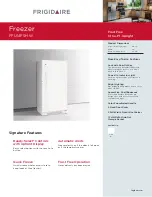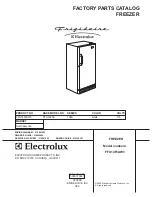
position is obtained by tuming the knob coun-
ter-clockwise whereas tuming clockwise gives
the lowest temperature.
The temperature in the freezer depends on the
ambient temperature, the quantity of goods, the
temperature of the goods when placed in the
freezer, how often the lid is opened, etc. If the
freezer is full the thermostat is set on a lower
temperature in order to ensure that the storage
temperature is sufficiently low also in the upper
packages.
Lamps (some models only)
The alarm lamp (red) lights up if the inside tem-
perature of the chest freezer becomes too high,
i.e there is a risk that the frozen foods will thaw.
In the following situations the lamp may light up
without there being any risk as to the frozen
foods:
-
when starting up the appliance,
-
when placing major quantities of fresh
foods in the appliance and
-
if the lid has been opened for some time.
The mains-on lamp (green) will stay lit as long
as the appliance is connected to the mains out-
let and as long as the automatic adjustment of
temperature functions. If the mains plug is re-
moved or if the power supply fails due to other
reasons the lamp will switch off.
Starting
The freezer is plugged in and the thermostat is
set so that the temperature is always below
-18°C. Let the freezer run for a few hours be-
fore the frozen foods are placed in the freezer.
Packing and placing
The packing of the goods must be air- and mois-
ture-proof to avoid drying. The freezer should
only be filled up to 30 mm (12 in) from the edge
of the inner tank.
Do not put bottles in the freezer to cool as the
liquid may burst the bottles when freezing.
Storage times
Notice that the storage times vary with the dif-
ferent foods. See the handbooks to the storage
of foods.
In case of prepacked frozen foods the manu-
facturer’s instructions should always be followed.
General advice
If the freezer will not start the following points
should be checked before you call in a service
engineer:
- that the plug is plugged in properly.
- that the fuse has not blown or breaker triffed.
- that the power supply has not been interrupted.
If the compressor makes repeated attempts to
start but still does not start running, tum off the
freezer and let the compressor rest for 15 to 20
minutes before another attempt to start is made.
It is quite normal that sometimes the freezer
feels warm on the outside. This is due to the
fact that the heat developed during the freezing
process is emitted from the outer casing. At the
same time this heat prevents condensation of
moisture which could otherwise result in rust-
ing.
Defrosting
Frost on the inner sides of the freezer cannot
be avoided. The formation of frost is the result
of the moisture of the air moving towards the
cold surfaces of the freezer.
Note! Non-tight-fitting packing also gives off
moisture which contributes to the formation of
frost. The lid should not be opened unneces-
sarily and never be left open for long. A thin
coat of frost or ice does not disturb the func-
tioning of the freezer. When the coat of frost or
ice is approx. 5 mm (0.2 in) thick the freezer
should be defrosted.
The current is switched off. The goods are re-
moved, packed in newspapers, blankets, or
simili and placed in a cool place.
Loose frost may carefully be removed with a
plastic scraper. Never use a knife or other sharp
tool which may damage the freezer or the re-
frigerating system. The defrosting may be has-
tened by placing one or more bowls with hot
water in the freezer. After some time the lid is
opened and the loosened coat of ice is care-
fully removed. Never hasten the defrosting with
other source of heat than hot water as you may
otherwise damage the material of the freezer
or even cause a fire.
The defrosting should always be combined with
a cleaning of the freezer.






















